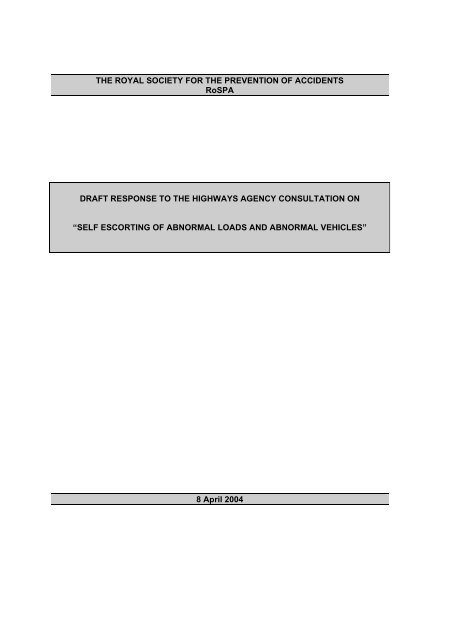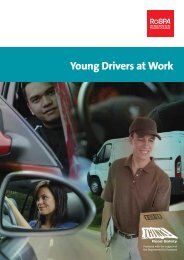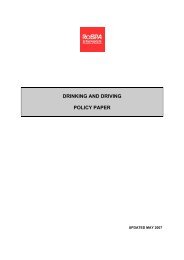Self Escorting Abnormal Loads and Abnormal Vehicles - RoSPA
Self Escorting Abnormal Loads and Abnormal Vehicles - RoSPA
Self Escorting Abnormal Loads and Abnormal Vehicles - RoSPA
Create successful ePaper yourself
Turn your PDF publications into a flip-book with our unique Google optimized e-Paper software.
THE ROYAL SOCIETY FOR THE PREVENTION OF ACCIDENTS<br />
<strong>RoSPA</strong><br />
DRAFT RESPONSE TO THE HIGHWAYS AGENCY CONSULTATION ON<br />
“SELF ESCORTING OF ABNORMAL LOADS AND ABNORMAL VEHICLES”<br />
8 April 2004
The Royal Society for the Prevention of Accidents<br />
Response to the Highways Agency Consultation Paper<br />
“Proposed Code of Practice<br />
<strong>Self</strong>-<strong>Escorting</strong> of <strong>Abnormal</strong> <strong>Loads</strong> <strong>and</strong> <strong>Abnormal</strong> <strong>Vehicles</strong>”<br />
April 2004<br />
“Proposed Code of Practice: <strong>Self</strong>-<strong>Escorting</strong> of <strong>Abnormal</strong> <strong>Loads</strong> <strong>and</strong> <strong>Abnormal</strong><br />
<strong>Vehicles</strong>”<br />
This is the response of the Royal Society for the Prevention of Accidents (<strong>RoSPA</strong>) to<br />
the Highways Agency’s consultation paper. <strong>RoSPA</strong> welcomes the invitation to<br />
comment, <strong>and</strong> our response has been prepared following consultation with <strong>RoSPA</strong>’s<br />
National Road Safety Committee.<br />
GENERAL COMMENTS<br />
<strong>RoSPA</strong> welcomes the introduction of a code of practice for the self-escorting of<br />
abnormal loads <strong>and</strong> abnormal vehicles, although we feel that the proposed Code<br />
needs to be strengthened.<br />
We believe that it was right to retain the legal duties on hauliers to notify the Police<br />
<strong>and</strong> Highways Authorities before moving an abnormal load or vehicle.<br />
It is important that Police time that is no longer need for escorting wide loads <strong>and</strong><br />
abnormal vehicles is re-allocated to other roads policing duties to ensure that these<br />
changes do not lead to a lower police profile on our roads.<br />
<strong>RoSPA</strong> is surprised that the Code of Practice does not include information on how<br />
these new escort methods will be advertised to the motoring public. The escort<br />
vehicles <strong>and</strong> escort personnel are new concepts. The motoring public need to be<br />
made aware that these vehicles will be on the road, their legal status, the duties <strong>and</strong><br />
responsibilities of the personnel in charge of them <strong>and</strong> how they should behave<br />
around these wide loads <strong>and</strong> abnormal vehicles.<br />
As a separate matter, it would be useful to be able to identify accidents <strong>and</strong><br />
casualties involving abnormal vehicles <strong>and</strong> abnormal loads separately from those<br />
involving normal HGVs. This could inform the development of future guidance.<br />
SPECIFIC COMMENTS<br />
1 Introduction<br />
<strong>RoSPA</strong> Response<br />
The Code of Practice provides voluntary practical guidelines which can be adapted<br />
“in appropriate circumstances”. There should be a mechanism to ensure that the<br />
Code is regularly reviewed so that it can be amended in the light of experience <strong>and</strong><br />
practice. The greater flexibility allowed by the system should cause less<br />
inconvenience to the motoring public, but they need to be made aware that this new<br />
system will be coming into operation <strong>and</strong> its implications.<br />
The Code of Practice provides for st<strong>and</strong>ardised practice across Scotl<strong>and</strong>, Engl<strong>and</strong><br />
<strong>and</strong> Wales. However, the lack of legal status of the Accredited Level 2 escort person<br />
in Scotl<strong>and</strong> may cause problems when loads <strong>and</strong> vehicles are moving between<br />
Engl<strong>and</strong> <strong>and</strong> Wales. <strong>RoSPA</strong> has concerns that this issue does not appear to have<br />
been addressed in the Code of Practice.<br />
1
The Royal Society for the Prevention of Accidents<br />
Response to the Highways Agency Consultation Paper<br />
“Proposed Code of Practice<br />
<strong>Self</strong>-<strong>Escorting</strong> of <strong>Abnormal</strong> <strong>Loads</strong> <strong>and</strong> <strong>Abnormal</strong> <strong>Vehicles</strong>”<br />
April 2004<br />
2 <strong>Self</strong> Certification<br />
<strong>RoSPA</strong> Response<br />
The Code of Practice requires hauliers <strong>and</strong> sub contractors to ensure that their staff<br />
<strong>and</strong> vehicles comply with the code of practice <strong>and</strong> that staff can carry out their duties<br />
competently in accordance with road traffic <strong>and</strong> health <strong>and</strong> safety legislation. The<br />
Police have the power to ask to see a self-certificate or other evidence of compliance<br />
with the Code of Practice.<br />
<strong>RoSPA</strong> would recommend that these checks be made on a regular basis to ensure<br />
that the Code of Practice is being correctly followed. Failure to comply with road<br />
traffic <strong>and</strong> health <strong>and</strong> safety legislation could have major consequences.<br />
3 Vehicle Requirements<br />
<strong>RoSPA</strong> Response<br />
The Code of Practice states that the primary role of any escort vehicle is to alert<br />
other road users to the presence of an abnormal load or vehicle. To be successful in<br />
this role, the public must be aware of what the vehicle is <strong>and</strong> this can only be<br />
achieved by advertising their existence <strong>and</strong> appearance. This necessity is not<br />
covered in the Code of Practice.<br />
Where they are employed, an accredited Level 2 person has a role in controlling <strong>and</strong><br />
directing traffic. The motoring public need to be made aware of this role <strong>and</strong> the<br />
authority that such staff have to direct traffic. They are used to being directed by<br />
police officers or traffic wardens, but not Level 2 persons.<br />
The vehicle specifications on size <strong>and</strong> type, colour, exterior lights, markings <strong>and</strong><br />
identification, equipment <strong>and</strong> information to be carried in Escort <strong>Vehicles</strong> appear to<br />
be comprehensive. <strong>RoSPA</strong>’s one reservation is in the area of conspicuity where the<br />
uniform colours of white, yellow, orange or silver are recommended rather than a<br />
‘battenburg’ effect which research has shown to be best for conspicuity. However,<br />
the comprehensive chevron markings on the rear <strong>and</strong> to the side of the vehicle<br />
should have a similar effect.<br />
2
The Royal Society for the Prevention of Accidents<br />
Response to the Highways Agency Consultation Paper<br />
“Proposed Code of Practice<br />
<strong>Self</strong>-<strong>Escorting</strong> of <strong>Abnormal</strong> <strong>Loads</strong> <strong>and</strong> <strong>Abnormal</strong> <strong>Vehicles</strong>”<br />
April 2004<br />
4 Escort Person Specification<br />
<strong>RoSPA</strong> Response<br />
The Code of Practice defines two levels of ‘escort person’ :<br />
• level 1 who have no powers to stop or direct traffic<br />
• level 2 who will have an accreditation from a Police Constable to undertake the<br />
traffic direction of other road users.<br />
Comprehensive Job Descriptions for both posts are provided but <strong>RoSPA</strong> is<br />
concerned that the route to achieve accreditation has not yet been fully defined.<br />
Also, since this is a voluntary code of practice there are no enforcement measures in<br />
place to ensure that recruits meet these criteria.<br />
The Code states that it is the responsibility of hauliers or sub-contractors to satisfy<br />
themselves that their own escort personnel are sufficiently competent to carry out<br />
their duties. No doubt, in the event of an incident, the Police <strong>and</strong>/or HSE would<br />
investigate whether escort personnel were competent. However, The Code should<br />
include some mechanism for external checks without the need to wait for an incident<br />
to occur.<br />
5 Operation<br />
<strong>RoSPA</strong> Response<br />
<strong>RoSPA</strong> welcomes the requirement that the police abnormal load officer <strong>and</strong> the<br />
haulier agree the numbers of escort vehicles <strong>and</strong> personnel on a case-by-case basis.<br />
Escort persons are required to risk assess traffic <strong>and</strong> weather conditions, but this is<br />
not included in the Job Descriptions included in the previous sections. <strong>RoSPA</strong> would<br />
prefer to see this included in the job responsibilities to emphasise the importance of<br />
this item.<br />
In the case of breakdown, escort personnel are responsible for coning off the<br />
abnormal loads or vehicle. Therefore, it would be appropriate to include a clause in<br />
the job description that staff members are responsible for ensuring their own <strong>and</strong><br />
others’ safety.<br />
There is little specific advice for escorts or the drivers of abnormal loads <strong>and</strong> vehicles<br />
on how to perform in different types of road <strong>and</strong> traffic conditions. This means the<br />
advice is somewhat vague <strong>and</strong> open to interpretation.<br />
<strong>Escorting</strong> Criteria<br />
The Code provides escorting criteria, which are for guidance only, <strong>and</strong> can be varied<br />
by individual police forces. <strong>RoSPA</strong> would prefer to see basic st<strong>and</strong>ards for both<br />
motorways <strong>and</strong> all other roads above which an escort must be provided. Many<br />
abnormal loads need to be transported across police area boundaries <strong>and</strong><br />
differences between police forces could lead to confusion.<br />
3
The Royal Society for the Prevention of Accidents<br />
Response to the Highways Agency Consultation Paper<br />
“Proposed Code of Practice<br />
<strong>Self</strong>-<strong>Escorting</strong> of <strong>Abnormal</strong> <strong>Loads</strong> <strong>and</strong> <strong>Abnormal</strong> <strong>Vehicles</strong>”<br />
April 2004<br />
The criteria does not include speed. As some abnormal loads <strong>and</strong> vehicles move at<br />
slow speeds, the inclusion of a speed criteria should be considered. For example, a<br />
large vehicle moving at no more than 30 mph on a 70 mph dual carriageway<br />
represents a hazard even if it is not wide enough to protrude into the outside lane.<br />
<strong>RoSPA</strong> welcomes the inclusion of clauses highlighting the need for a police escort on<br />
certain routes or in certain situations, <strong>and</strong> that special order loads may require a<br />
combination of police <strong>and</strong> self-escort vehicles.<br />
The Society thanks the Highways Agency for the opportunity to comment on these<br />
proposals. We have no objections to our response being reproduced or attributed.<br />
Road Safety Department<br />
<strong>RoSPA</strong><br />
Edgbaston Park<br />
353 Bristol Road<br />
Birmingham B5 7ST<br />
0121 248 2000<br />
www.rospa.com<br />
4
















